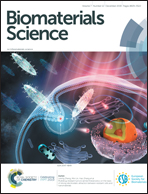Kidney-targeted triptolide-encapsulated mesoscale nanoparticles for high-efficiency treatment of kidney injury†
Abstract
Bad water solubility and undesired toxicity of triptolide (TP) still restrict its clinical applications in renal diseases. In this work, well-defined, monodispersed, and uniform-sized TP-encapsulated mesoscale nanoparticles (TP-MNPs) were fabricated through a nanoprecipitation method, which possesses special kidney-targeting capacity, slow-release property, and high-efficiency treatment for renal ischaemia-reperfusion injury (IRI). The TP-MNPs had good cytocompatibility in wide TP concentration (0–500 ng ml−1) and time ranges (6–24 h). Ex vivo organ fluorescence imaging and pharmacokinetic analysis suggested that TP-MNPs possessed excellent kidney-targeting capability with long retention time (7 days). The TP-MNPs with a very low dose of TP (0.01 mg kg−1) could effectively protect the kidney against IRI, while 0.01 mg kg−1 TP was completely ineffective. After treatment with TP-MNPs, the serum creatine, blood urea nitrogen, expression of C3 complement, and phospho-extracellular signal-regulated kinase of renal IRI mice were estimated to be 5.9-, 2.0-, 5.4-, and 2.8-fold lower than those of the mice treated with TP, respectively. Compared with TP, the TP-MNPs exhibited ignorable hepatotoxicity, reproductive toxicity, and immunotoxicity, such as lower alanine aminotransferase (0.5 fold) and aspartate aminotransferase (0.2 fold), and a higher ratio of CD4+/CD8+ (2.2 fold). Thus, the monodispersed and uniform-sized TP-MNPs with special kidney-targeting and slow-release property may pave an avenue for designing a new therapeutic strategy for renal diseases.



 Please wait while we load your content...
Please wait while we load your content...